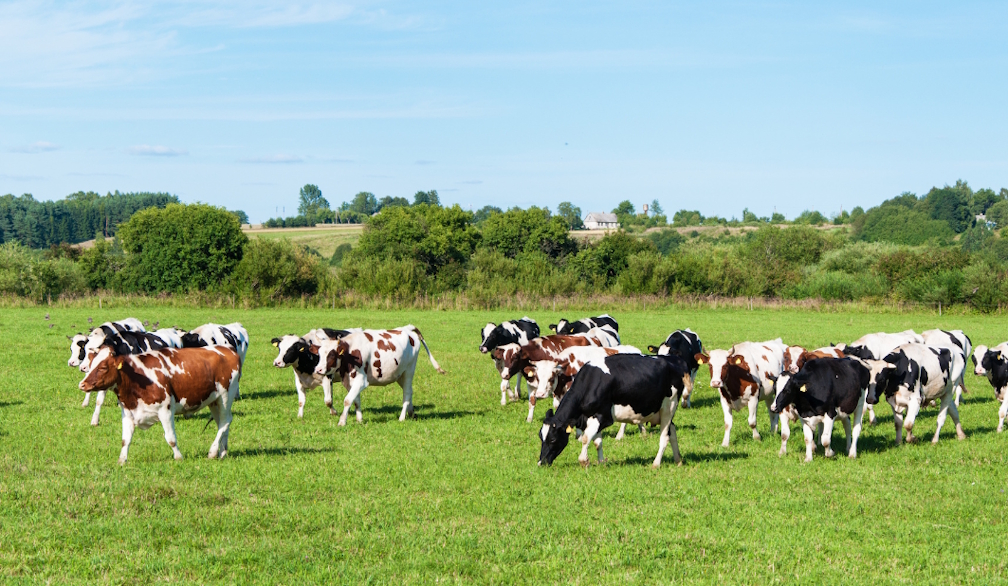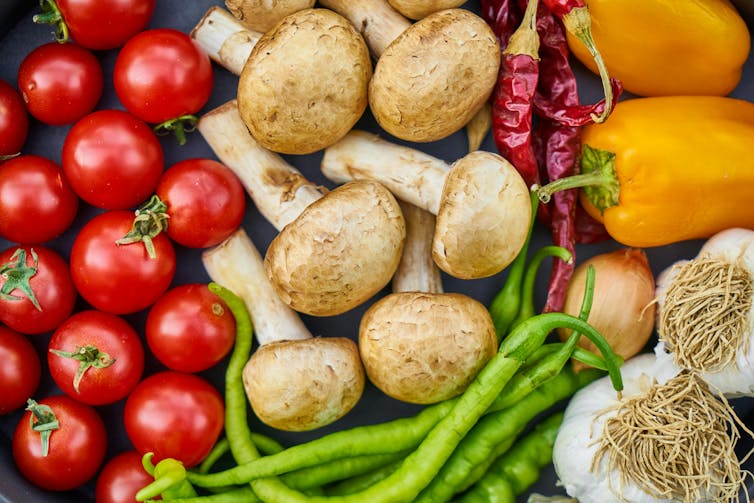3 ways farming can shift from climate culprit to solution
- Written by Budiman Minasny, Professor in Soil-Landscape Modelling, University of Sydney

Producing and distributing food is responsible for roughly a third[1] of global greenhouse gas emissions. But food systems are highly vulnerable[2] to the droughts, floods, fires and heatwaves made more intense by climate change. Agriculture is both culprit and victim.
As negotiators try to thrash out progress on climate in Brazil during the COP30 talks[3], agriculture will be a defining battleground. Hundreds of lobbyists for big agribusiness[4] are present, while outside the conference halls, people’s movements push for[5] low-impact farming.
In energy and transport, power sources and vehicles can be shifted to clean options to cut emissions. But it’s harder to cut emissions from farming. Agricultural emissions come largely from animals, crops and food processing – methane from cattle, sheep and goats[6], nitrous oxide[7] created by microbes in fertilised soils and carbon losses[8] from degraded land, where soil disturbance and erosion accelerate release of carbon dioxide.
Many countries have included[9] agriculture as a way to tackle climate change in their national commitments. The question is how. One solution is to focus on making farming regenerative rather than extractive.
Our research[10] has laid out an approach centred on net zero, nature positive and nutritionally balanced farming (3N for short). The goal: moving away from a narrow focus on cutting emissions to rebuild soil carbon, restore biodiversity and improve human nutrition simultaneously. Many people are already farming like this around the world, but rarely in a joined up way or at scale. Here’s what it looks like.
Farming for net zero
Farmers can help achieve net zero and cut costs by reducing emissions and building soil carbon stocks.
Imagine a wheat and livestock farm using precise ways to apply nitrogen fertilisers[13] only when and where plants can absorb it. Soil sensors and satellite imagery guide decisions about fertilising and irrigating. New technologies create fertiliser[14] out of the nitrogen in the air without the large carbon footprint[15] of traditional methods.
Planting nitrogen-fixing legumes[16] on fallow fields restores soil organic matter and cuts how much expensive fertiliser is needed. Beneficial microbes[17] are added to soils to boost carbon storage. Livestock are fed methane-reducing additives, while electric[18] or hydrogen-powered tractors[19] cleanly handle field operations. Animal manure and crop residues are transformed from waste into fertiliser and renewable energy[20].
The result: fewer emissions, healthier soils and lower bills for farmers.
Farming for nature positive
Because agriculture takes up half[21] the world’s habitable land, it makes sense to bring back nature wherever possible. But restoring habitat and bringing back species isn’t just decoration – it’s infrastructure. Instead of bare fencelines and bulldozed creekbeds, a 3N farm weaves nature through its working landscape. Hedgerows, shelterbelts and native vegetation corridors[22] link habitats and encourage the return of birds, insects and pollinators.
For farmers, this has real utility. Trees shade livestock, groundcovers cool soils, beneficial insects[23] pollinate crops and eat pests and vegetation belts filter runoff, reducing nutrient pollution in dams and waterways. Livestock are moved around so paddocks can recover, allowing native grasses to thrive. Soil organisms and organic matter rebuild, improving how the soil holds water, and reducing erosion. Farm productivity remains high while resilience rises.
Farming for nutritional balance
Healthier, more nutritious food comes from farms with healthier soils[24] and landscapes. To boost nutrition levels, farmers can shift from planting a single crop every year to a rotation including pulses, oilseeds and vegetables, improving soil fertility, nutrient cycling by microbes and plant health.
This nutrient-balanced farming approach boosts levels of essential nutrients in crops. But it has other benefits. By matching fertiliser inputs to crop needs, recycling organic residues and encouraging soil microbes and creatures to return, levels of nitrogen and phosphorus fall. This reduces the chance of polluted waterways or emissions of nitrous oxide. On Australian dairy farms, programs such as DairyUP[25] work to produce more nutrient-rich milk while lowering emissions and energy use.
It’s possible to boost nutrient levels rapidly but temporarily though biofortification[26], which includes adding nutrient-rich soil supplements and adding beneficial microbes which increase nutrient uptake. Longer lasting improvements to nutrient levels are possible through genetic tweaks[27].
When net zero, nature positive and nutrient-rich farming coexist, the benefits compound[28]. Farmers can cut costs, regenerate landscapes, cut emissions, build carbon stocks in soils and give people nutrient-rich food at the same time.

Which way forward?
Agriculture appears prominently in Brazil’s COP30 Action Agenda[31], but only in broad strokes. What’s missing is a clear framework which links climate, nature and nutrition. The 3N farming approach could help fill that gap.
Technologies are not the barrier. We already have precision agriculture to cut fertiliser use, feed additives to reduce methane, cover crops to rebuild soil nitrogen naturally, accurate biodiversity monitoring using eDNA[32] and digital twin technology able to test management decisions and predict outcomes on models without risking losses on real farms.
The real challenge is uptake. These methods have to be scaled up rapidly, aided by government policies and incentives.
At the ongoing COP30 talks, agriculture has shown some signs of moving from the margins to the centre of climate solutions, such as work on building resilient food systems[33]. But as yet there’s not a unified pathway laying out how to make agriculture the solution it can be. A key gap is soil security – ensuring soils are healthy enough[34] to keep producing.
The farm of the future is not a fantasy. It is already emerging in New Zealand dairy sheds[35], Australian trials[36] helping farmers make data-backed decisions about pasture varieties, European paddocks[37] combining trees and agriculture and Indigenous land-stewarded landscapes[38] worldwide.
No other sector of the economy can do so much. Only farming can tackle climate change, restore habitats and give people nutritious food. Agriculture isn’t a problem – it’s an essential part of the solution.
References
- ^ roughly a third (doi.org)
- ^ highly vulnerable (doi.org)
- ^ COP30 talks (unfccc.int)
- ^ big agribusiness (www.theguardian.com)
- ^ push for (www.desmog.com)
- ^ cattle, sheep and goats (www.agriculture.gov.au)
- ^ nitrous oxide (www.csiro.au)
- ^ carbon losses (doi.org)
- ^ have included (www.globalissues.org)
- ^ research (doi.org)
- ^ Matthias Zomer/Pexels (www.pexels.com)
- ^ CC BY-NC-ND (creativecommons.org)
- ^ apply nitrogen fertilisers (doi.org)
- ^ create fertiliser (www.sydney.edu.au)
- ^ large carbon footprint (www.cam.ac.uk)
- ^ nitrogen-fixing legumes (www.youtube.com)
- ^ microbes (doi.org)
- ^ electric (thedriven.io)
- ^ hydrogen-powered tractors (fuelcellsworks.com)
- ^ renewable energy (biomassproducer.com.au)
- ^ takes up half (ourworldindata.org)
- ^ corridors (www.dcceew.gov.au)
- ^ beneficial insects (www.lls.nsw.gov.au)
- ^ healthier soils (doi.org)
- ^ DairyUP (dairyup.com.au)
- ^ biofortification (www.who.int)
- ^ genetic tweaks (ses.library.usyd.edu.au)
- ^ benefits compound (europepmc.org)
- ^ Engin Akyurt/Pexels (www.pexels.com)
- ^ CC BY-NC-ND (creativecommons.org)
- ^ COP30 Action Agenda (cop30.br)
- ^ eDNA (doi.org)
- ^ resilient food systems (www.unfoodsystemshub.org)
- ^ healthy enough (doi.org)
- ^ dairy sheds (www.dairynz.co.nz)
- ^ Australian trials (www.pasturetrials.com.au)
- ^ European paddocks (forest.eea.europa.eu)
- ^ Indigenous land-stewarded landscapes (www.ran.org)














